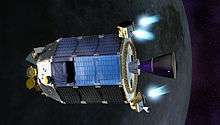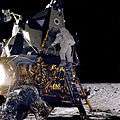Surveyor 1
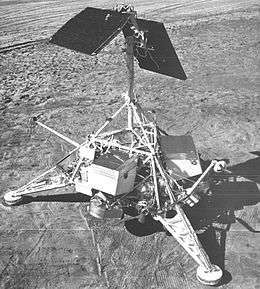 Surveyor model on Earth | |
| Mission type | Lunar lander |
|---|---|
| Operator | NASA |
| COSPAR ID | 1966-045A |
| SATCAT № | 02185 |
| Mission duration | 65 hours |
| Spacecraft properties | |
| Manufacturer | Hughes Aircraft |
| Launch mass | 995.2 kilograms (2,194 lb) |
| Landing mass | 292 kilograms (644 lb) |
| Start of mission | |
| Launch date | May 30, 1966, 14:41:01 UTC |
| Rocket | Atlas LV-3C Centaur-D |
| Launch site | Cape Canaveral LC-36A |
| End of mission | |
| Last contact | 7 January 1967 |
| Lunar lander | |
| Landing date | June 2, 1966, 06:17:36 UTC[1] |
| Landing site | 2°28′26″S 43°20′20″W / 2.474°S 43.339°W[1] |
Surveyor 1 was the first lunar soft-lander in the unmanned Surveyor program of the National Aeronautics and Space Administration (NASA, United States). This lunar soft-lander gathered data about the lunar surface that would be needed for the manned Apollo Moon landings that began in 1969. The successful soft landing of Surveyor 1 on the Ocean of Storms was the first one by an American space probe onto any extraterrestrial body, and it occurred just four months after the first Moon landing by the Soviet Union's Luna 9 probe. This was also a success on NASA's first attempt at a soft landing on any astronomical object.
Surveyor 1 was launched May 30, 1966, from the Cape Canaveral Air Force Station at Cape Canaveral, Florida, and it landed on the Moon on June 2, 1966. Surveyor 1 transmitted 11,237 still photos of the lunar surface to the Earth by using a television camera and a sophisticated radio-telemetry system.
The Surveyor program was managed by the Jet Propulsion Laboratory, in Los Angeles County, California, but the entire Surveyor space probe was designed and built by the Hughes Aircraft Company in El Segundo, California.
Mission description


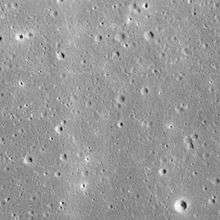
The Surveyor series of space probes was designed to carry out the first soft landings on the Moon by any American spacecraft. No instrumentation was carried specifically for scientific experiments by Surveyor 1, but considerable scientific data were collected by its television camera and then returned to Earth via the Deep Space Network from 1966 to 1967. These spacecraft carried two television cameras — one for its approach, which was not used in this case, and one for taking still pictures of the lunar surface. Over 100 engineering sensors were on board each Surveyor. Their television systems transmitted pictures of the spacecraft footpad and surrounding lunar terrain and surface materials. These spacecraft also acquired data on the radar reflectivity of the lunar surface, the load-bearing strength of the lunar surface, and the temperatures for use in the analysis of the lunar surface temperatures. (Later Surveyor space probes, beginning with Surveyor 3, carried scientific instruments to measure the composition and mechanical properties of the lunar "soil".)
Surveyor 1 was launched May 30, 1966 and sent directly into a trajectory to the Moon without any parking orbit. Its retrorockets were turned off at a height of about 3.4 meters above the lunar surface. Surveyor 1 fell freely to the surface from this height, and it landed on the lunar surface on June 2, 1966, on the Oceanus Procellarum. This location was at 2°28′26″S 43°20′20″W / 2.474°S 43.339°W.[1]
The duration of the spaceflight of Surveyor 1 was about 63 hours, 30 minutes. Surveyor I's lunar launch weight was about 995.2 kilograms (2,194 lb), and its landing weight (minus expended maneuvering propellant, its solid-fueled retrorocket (which had been jettisoned), and its radar altimeter system) was about 294.3 kilograms (649 lb).
Surveyor 1 transmitted video data from the Moon beginning shortly after its landing through July 14, 1966, but with a period of no operations during the two-week long lunar night of June 14, 1966 through July 7, 1966. Because the Moon always presents the same face to Earth, "line-of-sight" radio communications with Surveyor 1 required only changes in ground stations as the Earth rotated. However, since it was solar-powered, Surveyor 1 had no electricity with which to do anything at all during the two weeks of the lunar nights.
The return of engineering information (temperatures, etc.) from Surveyor 1 continued through January 7, 1967, with several interruptions during the lunar nights.
Science instruments
Television
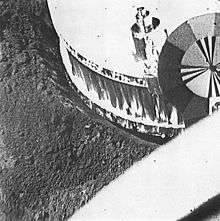
The TV camera consisted of a vidicon tube, 25 millimeter and 100 millimeter focal-length lenses, a shutter, several optical filters, and iris-system mounted along an axis inclined approximately 16 degrees from the central axis of Surveyor 1. The camera was mounted under a mirror that could be moved in azimuth and elevation. This arrangement created a virtual stereo image pair so that adjacent overlapping images were stereo image pairs and could be viewed as three-dimensional images. This stereo capability permitted some photogrammetric measurements of various lunar features. The TV camera's operation was dependent on the receipt of the proper radio commands from the Earth. Frame-by-frame coverage of the lunar surface was obtained over 360 degrees in azimuth and from +40 degrees above the plane normal to the camera's axis to -65 degrees below this plane. Both 600-line and 200-line modes of operation were used. The 200-line mode transmitted over an omnidirectional antenna for the first 14 photos and scanned one frame every 61.8 seconds. The remaining transmissions were of 600-line pictures over a directional antenna, and each frame was scanned every 3.6 seconds. Each 200-line picture required 20 seconds for a complete video transmission and it used a radio bandwidth of about 1.2 kilohertz.
Each 600-line picture required about one second to be read from the vidicon tube, and they required a radio bandwidth of about 220 kilohertz. The data transmissions were converted into a standard TV signal for both closed-circuit TV and broadcast TV. The television images were displayed on Earth on a slow-scan monitor coated with a long persistency phosphor. The persistency was selected to optimally match the nominal maximum frame rate. One frame of TV identification was received for each incoming TV frame, and it was displayed in real time at a rate compatible with the incoming image. These data were recorded on a video magnetic tape recorder. Over 10,000 pictures were taken by Surveyor 1's TV camera before the lunar sunset of June 14, 1966. Included in these pictures were wide-angle and narrow-angle panoramas, focus ranging surveys, photometric surveys, special area surveys, and celestial photography. Surveyor 1 responded to commands to activate the camera on July 7, and by July 14, 1966, it had returned nearly 1000 more pictures.
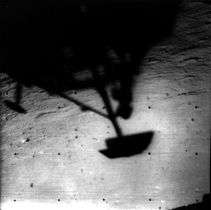 Surveyor 1's shadow against the lunar surface.
Surveyor 1's shadow against the lunar surface.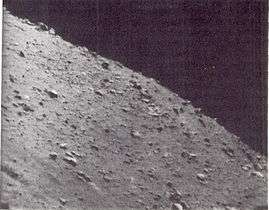 The mare surface
The mare surface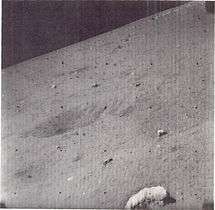 Another view of the mare surface
Another view of the mare surface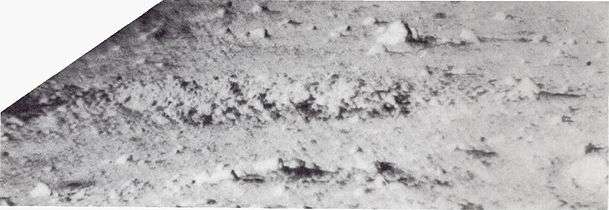 Irregularly shaped crater at the landing site
Irregularly shaped crater at the landing site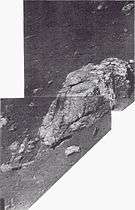 Mottled rock about 50 cm long near Surveyor 1
Mottled rock about 50 cm long near Surveyor 1
Strain gauge
Strain gauges were mounted on each leg shock absorber to record the peak axial forces at landing impact of the spacecraft. They were designed to accept a force of approximately 800 kgf (7.8 kN).
See also
- Surveyor Program
- Luna 9 — First successful lunar lander (Soviet Union)
References
- 1 2 3 "Surveyor 1". NASA Space Science Data Coordinated Archive. 2014-08-26. Archived from the original on 2015-06-01. Retrieved 2015-06-01.
External links
- Surveyor 1: 50 Years Later on YouTube
- Panoramas of the Surveyor 1 landing site, from The International Atlas of Lunar Exploration by Philip J. Stooke
- Surveyor Program Results (PDF) 1969
- Surveyor I - A Preliminary Report - June 1, 1966 (PDF)
- Surveyor I mission report. Part II - Scientific data and results - Sep 1966 (PDF)
- Details of Surveyor 1 launch, and also more on the Surveyor program
- Surveyor I images at Lunar and Planetary Institute
- Lunar Orbiter 1 photo 192, showing the northeastern part of Flamsteed P crater, where Surveyor 1 landed
